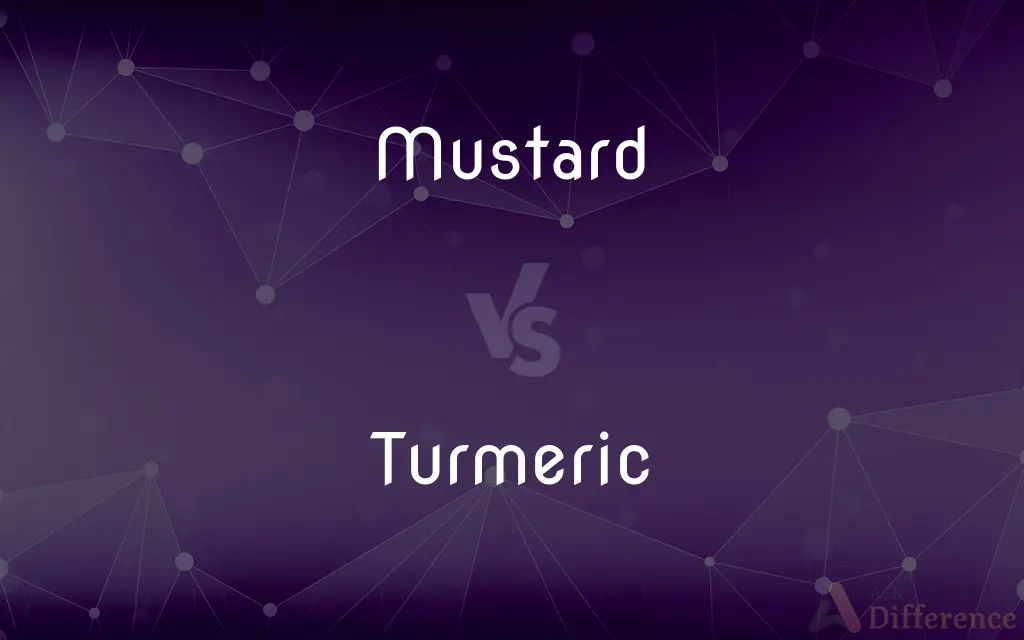Mustard vs. Turmeric — What's the Difference?
By Urooj Arif & Fiza Rafique — Updated on April 15, 2024
Mustard, derived from seeds of the mustard plant, is primarily used as a condiment and in sauces, while turmeric is a spice obtained from a root, famous for its role in flavoring and coloring dishes, especially in Indian cuisine.

Difference Between Mustard and Turmeric
Table of Contents
ADVERTISEMENT
Key Differences
Mustard is typically processed into a paste or sauce from the seeds of various mustard plants, commonly used in Western cuisine to enhance sandwiches, hot dogs, and burgers. On the other hand, turmeric comes from the root of the Curcuma longa plant, primarily used as a ground spice that imparts a distinctive yellow color and earthy flavor to dishes like curries and mustards.
The taste of mustard can vary from sweet to spicy, depending on the type of mustard seeds and preparation method. Whereas turmeric has a warm, bitter taste and is often used to complement other spices within complex flavor profiles, such as in Indian and Middle Eastern dishes.
Mustard seeds also serve as a base for various types of mustards including Dijon, yellow mustard, and whole grain mustard, each offering different flavors and textures. Turmeric, however, is mostly used in its powdered form and is a key ingredient in curry powder, contributing significantly to its golden hue.
Health-wise, mustard is known for its minimal calorie content and potential benefits from antioxidants. Turmeric is renowned for its anti-inflammatory and antioxidant properties, primarily due to curcumin, its active ingredient.
In culinary applications, mustard is often applied raw or at the end of cooking to preserve its pungent flavor. In contrast, turmeric is typically cooked with fats or oils to unlock its flavors and health benefits, and it's often used as part of a spice mix.
ADVERTISEMENT
Comparison Chart
Source
Seeds of mustard plants
Root of the Curcuma longa plant
Primary Use
Condiment, sauces
Spice, coloring
Taste
Varies from sweet to spicy
Warm, bitter
Common Forms
Paste, whole seeds, powder
Powdered, raw root
Health Benefits
Antioxidants, low calories
Anti-inflammatory, antioxidant
Compare with Definitions
Mustard
Seeds.
Mustard seeds are used both whole and ground in different recipes.
Turmeric
Coloring.
Turmeric gives a natural yellow color to fabrics and foods.
Mustard
Emulsifier.
Mustard is used as an emulsifier in vinaigrettes.
Turmeric
Anti-inflammatory.
Adding turmeric to dishes can help reduce inflammation.
Mustard
Condiment.
He spread mustard on his sandwich to add flavor.
Turmeric
Spice.
Turmeric is a staple spice in curry powder.
Mustard
Spice.
Ground mustard is used as a spice in various sauces.
Turmeric
Medicinal.
Turmeric supplements are popular for their anti-inflammatory properties.
Mustard
Medicinal.
Mustard plasters have been used historically for chest congestion.
Turmeric
Antioxidant.
Turmeric contains curcumin, a powerful antioxidant.
Mustard
A hot-tasting yellow or brown paste made from the crushed seeds of certain plants, typically eaten with meat or used as a cooking ingredient
Dijon mustard
Mustard sauce
Turmeric
Turmeric (pronounced , also or ) is a flowering plant, Curcuma longa of the ginger family, Zingiberaceae, the roots of which are used in cooking. The plant is a perennial, rhizomatous, herbaceous plant native to the Indian subcontinent and Southeast Asia, that requires temperatures between 20 and 30 °C (68 and 86 °F) and a considerable amount of annual rainfall to thrive.
Mustard
The yellow-flowered Eurasian plant of the cabbage family whose seeds are used to make mustard.
Turmeric
A widely cultivated tropical plant (Curcuma longa) of India, having yellow flowers and an aromatic, somewhat fleshy rhizome.
Mustard
A brownish yellow colour
A mustard sweater
Turmeric
The powdered rhizome of this plant, used as a spice and a yellow dye.
Mustard
Any of various Eurasian plants of the mustard family, especially white mustard, Indian mustard, and black mustard, which are cultivated for their pungent seeds and edible leaves.
Turmeric
Any of several other plants having similar rhizomes.
Mustard
A condiment made from the powdered seeds of certain of these plants.
Turmeric
(botany) An Indian plant, Curcuma longa, with aromatic rhizomes, part of the ginger family (Zingiberaceae).
Mustard
A member of the mustard family.
Turmeric
(cooking) The pulverized rhizome of the turmeric plant, used for flavoring and to add a bright yellow color to food.
Mustard
A dark yellow to light olive brown.
Turmeric
A yellow to reddish-brown dye extracted from the turmeric plant.
Mustard
Any of a group of toxic organic compounds that include mustard gas and the nitrogen mustards.
Turmeric
An East Indian plant of the genus Curcuma, of the Ginger family.
Mustard
A plant of certain species of the genus Brassica, or of related genera (especially Sinapis alba, in the family Brassicaceae, with yellow flowers, and linear seed pods).
Turmeric
The root or rootstock of the Curcuma longa. It is externally grayish, but internally of a deep, lively yellow or saffron color, and has a slight aromatic smell, and a bitterish, slightly acrid taste. It is used for a dye, a medicine, a condiment, and a chemical test.
Mustard
Powder or paste made from seeds of the mustard plant, and used as a condiment or a spice.
When the waitress brought the food, I asked whether she had any Dijon mustard.
Turmeric
Of or pertaining to turmeric; resembling, or obtained from, turmeric; specif., designating an acid obtained by the oxidation of turmerol.
Mustard
The leaves of the mustard plant, used as a salad.
Mustard and cress sandwiches.
Turmeric
Widely cultivated tropical plant of India having yellow flowers and a large aromatic deep yellow rhizome; source of a condiment and a yellow dye
Mustard
Dark yellow colour, the colour of mustard.
Turmeric
Ground dried rhizome of the turmeric plant used as seasoning
Mustard
One of a family of vesicants containing one or more 2-chloroethyl (C2H4Cl) groups, commonly used in chemical warfare and cancer chemotherapy.
Mustard
The tomalley of a crab, which resembles the condiment.
Mustard
Of a dark yellow colour.
Mustard
The name of several cruciferous plants of the genus Brassica (formerly Sinapis), as white mustard (Brassica alba), black mustard (Brassica Nigra), wild mustard or charlock (Brassica Sinapistrum).
Mustard
A powder or a paste made from the seeds of black or white mustard, used as a condiment and a rubefacient. Taken internally it is stimulant and diuretic, and in large doses is emetic.
Mustard
Any of several cruciferous plants of the genus Brassica
Mustard
Pungent powder or paste prepared from ground mustard seeds
Mustard
Leaves eaten as cooked greens
Common Curiosities
What is mustard made from?
Mustard is made from the seeds of mustard plants.
Which has more health benefits, mustard or turmeric?
Turmeric is generally considered to have more potent health benefits, especially due to its anti-inflammatory properties.
What are the main uses of turmeric?
Turmeric is primarily used as a spice and for coloring in cooking.
What dishes are mustard commonly used in?
Mustard is commonly used in sandwiches, salads, and hot dogs.
How do mustard seeds enhance food flavor?
Mustard seeds add a pungent and spicy flavor to dishes.
Can mustard be used in sweet dishes?
While less common, mustard can be used in sweet glazes and dressings.
Is turmeric hot like chili peppers?
No, turmeric is warm and bitter but not hot like chili peppers.
How is turmeric usually prepared in cooking?
Turmeric is usually cooked with fats or oils to enhance its flavor and health benefits.
Can turmeric be eaten raw?
Yes, turmeric root can be eaten raw, often grated into dishes for a fresh flavor.
How long can you store mustard?
Mustard can be stored for up to a year in a cool, dry place.
Are there different types of mustard?
Yes, there are several types of mustard, including yellow, Dijon, and whole grain.
Is mustard vegan?
Most mustards are vegan, though some recipes might include honey or other animal products.
Does turmeric have any side effects?
Excessive consumption of turmeric might lead to stomach upset or other digestive issues.
What are the cosmetic uses of turmeric?
Turmeric is used in many skincare products for its antioxidant and anti-inflammatory properties.
What is the primary flavor contribution of turmeric in dishes?
Turmeric contributes a warm, earthy, and slightly bitter flavor.
Share Your Discovery

Previous Comparison
Fade vs. Hook
Next Comparison
Roster vs. LineupAuthor Spotlight
Written by
Urooj ArifUrooj is a skilled content writer at Ask Difference, known for her exceptional ability to simplify complex topics into engaging and informative content. With a passion for research and a flair for clear, concise writing, she consistently delivers articles that resonate with our diverse audience.
Co-written by
Fiza RafiqueFiza Rafique is a skilled content writer at AskDifference.com, where she meticulously refines and enhances written pieces. Drawing from her vast editorial expertise, Fiza ensures clarity, accuracy, and precision in every article. Passionate about language, she continually seeks to elevate the quality of content for readers worldwide.












































